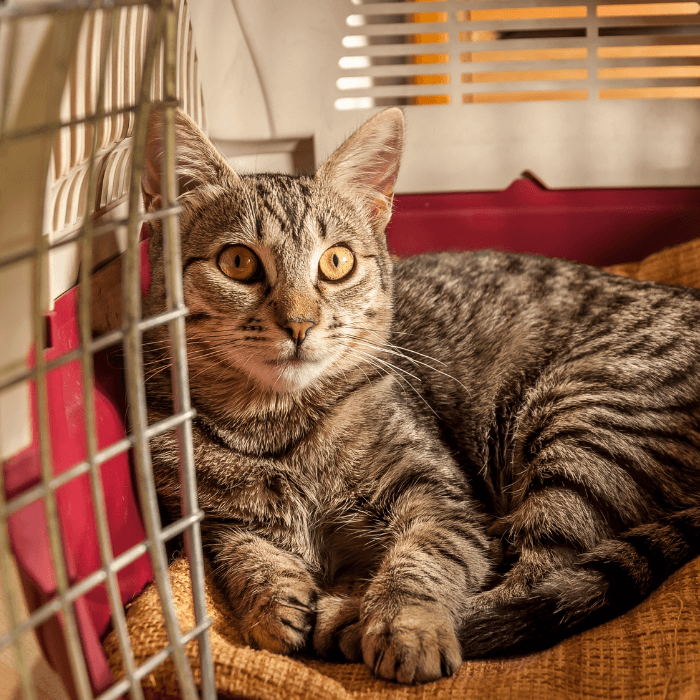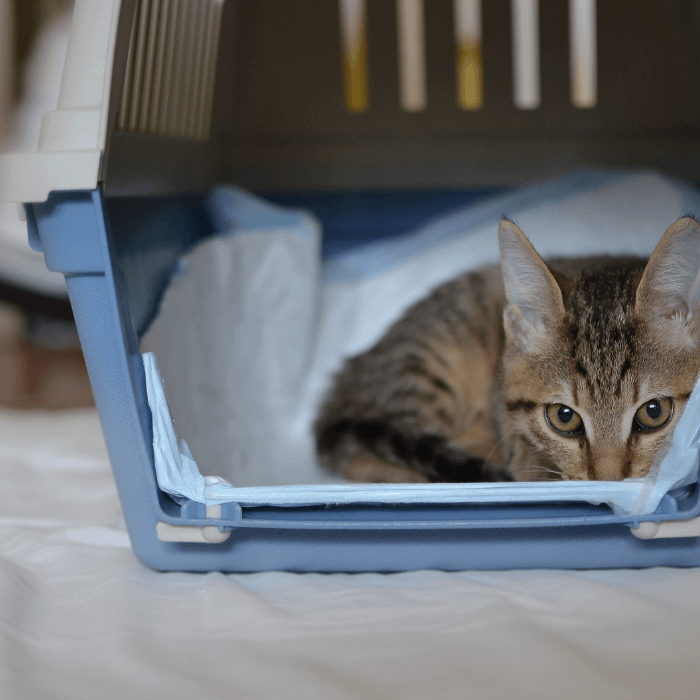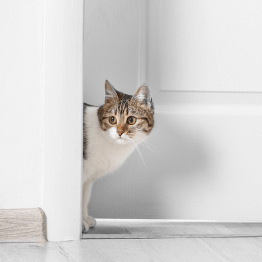TRAVELING WITH A CAT IN A CAR
It’s summer, and you know what that means? Vacation time! If you’re ready to shake off those winter blues and dive into sunshine purrfection, we hear you. There’s only one thing: what do you do with your cat?
Traveling with your cat can offer some pawsome companionship. After all, who likes driving alone for miles? Traveling with a cat in a car can provide a sense of fur-endship that no other passenger can.
The pawblem comes in when your cat isn’t adequately trained for these trips. Not only is having your cat jump from seat to seat going to be a major hazard, but it will also add an unnecessary element of stress. For this reason, we recommend cat carrier training.
Knowing how to get a cat in a carrier and getting it fur-miliar with the carrier is essential. Whether you’re going cross country or
just a quick trip to the beach, these tips will come in handy when traveling with your cat.
CAT CARRIER TRAINING TIPS
As some pawrents may know, getting your cat into the carrier is half of the struggle. If begging and pleading don’t work, you may want to try the following.
1. Purchase the Right Pet Carrier
First thing’s first, making sure your cat has a plush place to sit is key. Knowing the correct size and fit for the cat will be very important to the cat and you. The more comfortable they are, the less likely it will be that they’ll kick up a fuss.
2. Allow Them to Explore the Pet Carrier
One of the main reasons that cats don’t like their carriers is because it’s foreign. And who can blame them?
Sitting in an unknown crate for who knows how long? No thanks! After purchasing the carrier, let the cat get fur-miliar with their new accessory. Set the carrier in the cat area for a couple of days and let the cat investigate with it. Do not push the cat into the carrier, or your cat will not want to go in the carrier.
3. Create Paw-sitive Associations
Once they’ve settled, you will want to up the ante and help your cat get excited about the carrier. You can do this by putting their fur-vorite toys in it and see if the cat follows. This may require a few rounds of cat and mouse, but it pays off!
4. Reward Your Cat
Once you have the cat going in and playing with the item, then you will want to start with the rewarding of small treats. This is a fundamental part of learning how to get a cat in a carrier.
5. Explore Slowly
Give your cat a few days to settle in this new rhythm of exploring the carrier, getting treats, and playing. Once the cat is comfortable and maybe laying down in the pet carrier, you will want to start with short trips.
First, take your cat into a room with a door. Allow them to get into the carrier in their own time and leave the door slightly ajar (a Door Buddy will come in handy here!). We recommend doing this for a few days just to get your cat adjusted to being in a smaller space.
Next, when you know your cat is okay with being in the carrier in a room, you can start moving it around. You can pick up the carrier and carry the cat gently around the house. You should do this several times a day for a few days, just so the cat is used to the movement.
Now, it’s the big day: the first car ride. If your cat hasn’t been in the car before, it’s im-paw-tant to keep in mind that your cat may startle with the new sounds and environment.
Take your cat in the carrier and just sit in the car without movement. If they’re okay, start up the car and take a quick trip around the street. Are they still okay? Fur-bulous! Let this be their first trip. You may need to repeat this short journey for a few days until they’re less frazzled. After this, you should be good to go.
Need more guidance, our fur-ends over at Hire a Helper have some pawsome tips on Ultimate Guide To Moving Long Distance With Pets.
WHAT ELSE CAN YOU DO WHEN TRAVELING WITH A CAT?
Even with the best understanding of how to get a cat in a carrier and traveling with a cat in a car, they may still be frantic. These tips may help:
- Play soft music to help drown out loud sounds
- Talk to your cat and assure them that they’re okay
- Treat them often
If the cat does get frightened at any time, you will want to stop and help the cat relax. This will help assure your cat that there is nothing wrong. By offering this security, your cat will want to go back to the carrier the next time.
Do not at any time yell or do anything to startle the cat, as your cat will have a fear of the pet carrier.
Our best advice is to have patience and practice your cat carrier training often. The more time you give your cat to get adjusted to the idea of the cat carrier, the better they will be when it comes to traveling with a cat in a car. A happy cat makes for a fur-tastic vacation!








